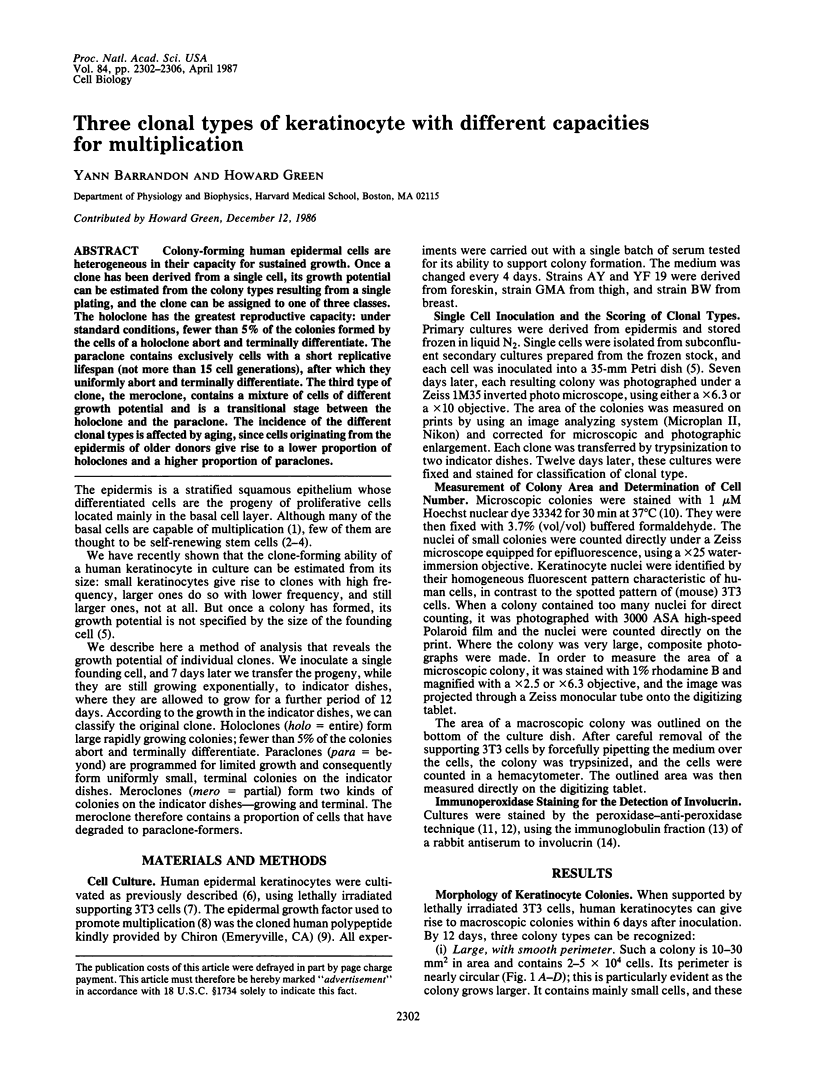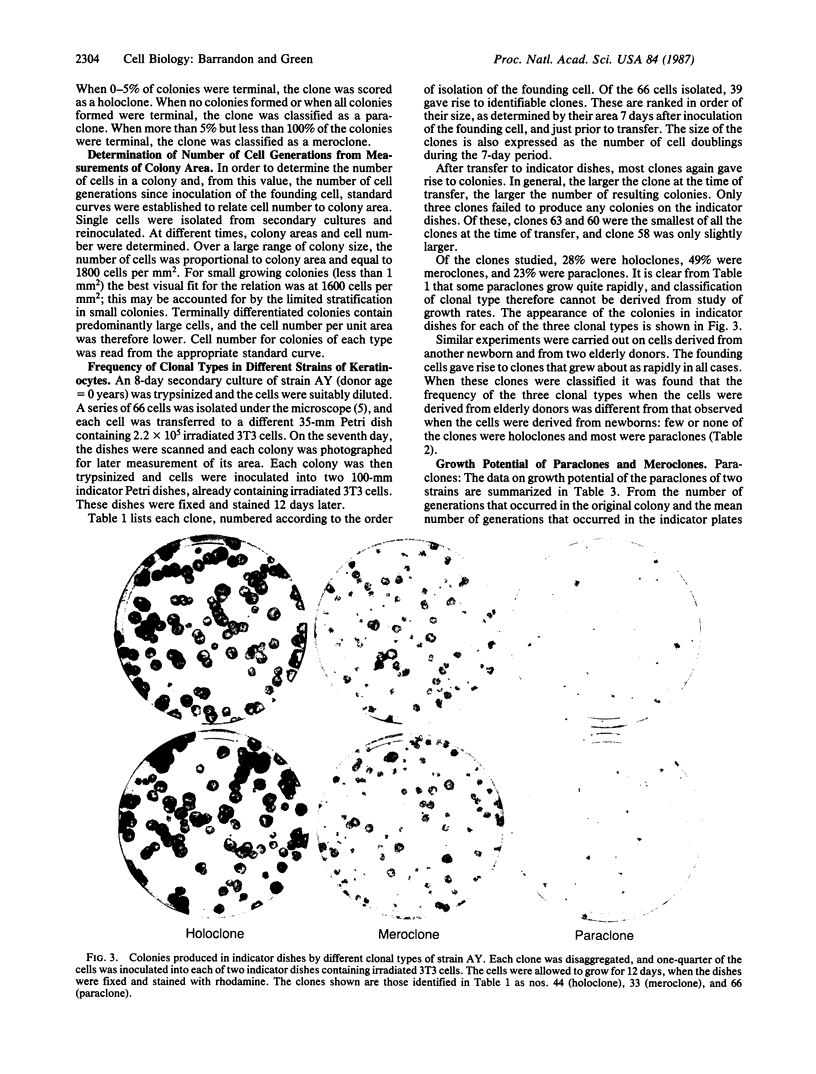Abstract
Colony-forming human epidermal cells are heterogeneous in their capacity for sustained growth. Once a clone has been derived from a single cell, its growth potential can be estimated from the colony types resulting from a single plating, and the clone can be assigned to one of three classes. The holoclone has the greatest reproductive capacity: under standard conditions, fewer than 5% of the colonies formed by the cells of a holoclone abort and terminally differentiate. The paraclone contains exclusively cells with a short replicative lifespan (not more than 15 cell generations), after which they uniformly abort and terminally differentiate. The third type of clone, the meroclone, contains a mixture of cells of different growth potential and is a transitional stage between the holoclone and the paraclone. The incidence of the different clonal types is affected by aging, since cells originating from the epidermis of older donors give rise to a lower proportion of holoclones and a higher proportion of paraclones.
Full text
PDF




Images in this article
Selected References
These references are in PubMed. This may not be the complete list of references from this article.
- Al-Barwari S. E., Potten C. S. Regeneration and dose-response characteristics of irradiated mouse dorsal epidermal cells. Int J Radiat Biol Relat Stud Phys Chem Med. 1976 Sep;30(3):201–216. doi: 10.1080/09553007614550981. [DOI] [PubMed] [Google Scholar]
- Albers K. M., Taichman L. B. Kinetics of withdrawal from the cell cycle in cultured human epidermal keratinocytes. J Invest Dermatol. 1984 Feb;82(2):161–164. doi: 10.1111/1523-1747.ep12259726. [DOI] [PubMed] [Google Scholar]
- Allen T. D., Dexter T. M. Ultrastructural aspects of erythropoietic differentiation in long-term bone marrow culture. Differentiation. 1982;21(2):86–94. doi: 10.1111/j.1432-0436.1982.tb01201.x. [DOI] [PubMed] [Google Scholar]
- Banks-Schlegel S., Green H. Involucrin synthesis and tissue assembly by keratinocytes in natural and cultured human epithelia. J Cell Biol. 1981 Sep;90(3):732–737. doi: 10.1083/jcb.90.3.732. [DOI] [PMC free article] [PubMed] [Google Scholar]
- Barrandon Y., Green H. Cell size as a determinant of the clone-forming ability of human keratinocytes. Proc Natl Acad Sci U S A. 1985 Aug;82(16):5390–5394. doi: 10.1073/pnas.82.16.5390. [DOI] [PMC free article] [PubMed] [Google Scholar]
- Gallico G. G., 3rd, O'Connor N. E., Compton C. C., Kehinde O., Green H. Permanent coverage of large burn wounds with autologous cultured human epithelium. N Engl J Med. 1984 Aug 16;311(7):448–451. doi: 10.1056/NEJM198408163110706. [DOI] [PubMed] [Google Scholar]
- Gilchrest B. A. In vitro assessment of keratinocyte aging. J Invest Dermatol. 1983 Jul;81(1 Suppl):184s–189s. doi: 10.1111/1523-1747.ep12541084. [DOI] [PubMed] [Google Scholar]
- Goldstein S., Littlefield J. W., Soeldner J. S. Diabetes mellitus and aging: diminished planting efficiency of cultured human fibroblasts. Proc Natl Acad Sci U S A. 1969 Sep;64(1):155–160. doi: 10.1073/pnas.64.1.155. [DOI] [PMC free article] [PubMed] [Google Scholar]
- HAYFLICK L. THE LIMITED IN VITRO LIFETIME OF HUMAN DIPLOID CELL STRAINS. Exp Cell Res. 1965 Mar;37:614–636. doi: 10.1016/0014-4827(65)90211-9. [DOI] [PubMed] [Google Scholar]
- Holliday R. The unsolved problem of cellular ageing. Monogr Dev Biol. 1984;17:60–77. [PubMed] [Google Scholar]
- Jensen P. K., Pedersen S., Bolund L. Basal-cell subpopulations and cell-cycle kinetics in human epidermal explant cultures. Cell Tissue Kinet. 1985 Mar;18(2):201–215. doi: 10.1111/j.1365-2184.1985.tb00649.x. [DOI] [PubMed] [Google Scholar]
- Lajtha L. G. Stem cell concepts. Differentiation. 1979;14(1-2):23–34. doi: 10.1111/j.1432-0436.1979.tb01007.x. [DOI] [PubMed] [Google Scholar]
- Lalande M. E., Ling V., Miller R. G. Hoechst 33342 dye uptake as a probe of membrane permeability changes in mammalian cells. Proc Natl Acad Sci U S A. 1981 Jan;78(1):363–367. doi: 10.1073/pnas.78.1.363. [DOI] [PMC free article] [PubMed] [Google Scholar]
- Lavker R. M., Sun T. T. Epidermal stem cells. J Invest Dermatol. 1983 Jul;81(1 Suppl):121s–127s. doi: 10.1111/1523-1747.ep12540880. [DOI] [PubMed] [Google Scholar]
- Lavker R. M., Sun T. T. Heterogeneity in epidermal basal keratinocytes: morphological and functional correlations. Science. 1982 Mar 5;215(4537):1239–1241. doi: 10.1126/science.7058342. [DOI] [PubMed] [Google Scholar]
- Martin G. M., Sprague C. A., Epstein C. J. Replicative life-span of cultivated human cells. Effects of donor's age, tissue, and genotype. Lab Invest. 1970 Jul;23(1):86–92. [PubMed] [Google Scholar]
- Martin G. M., Sprague C. A., Norwood T. H., Pendergrass W. R. Clonal selection, attenuation and differentiation in an in vitro model of hyperplasia. Am J Pathol. 1974 Jan;74(1):137–154. [PMC free article] [PubMed] [Google Scholar]
- Potten C. S. Cell replacement in epidermis (keratopoiesis) via discrete units of proliferation. Int Rev Cytol. 1981;69:271–318. doi: 10.1016/s0074-7696(08)62326-8. [DOI] [PubMed] [Google Scholar]
- Potten C. S., Wichmann H. E., Loeffler M., Dobek K., Major D. Evidence for discrete cell kinetic subpopulations in mouse epidermis based on mathematical analysis. Cell Tissue Kinet. 1982 May;15(3):305–329. doi: 10.1111/j.1365-2184.1982.tb01050.x. [DOI] [PubMed] [Google Scholar]
- Quinn L. S., Holtzer H., Nameroff M. Generation of chick skeletal muscle cells in groups of 16 from stem cells. Nature. 1985 Feb 21;313(6004):692–694. doi: 10.1038/313692a0. [DOI] [PubMed] [Google Scholar]
- Rheinwald J. G., Green H. Epidermal growth factor and the multiplication of cultured human epidermal keratinocytes. Nature. 1977 Feb 3;265(5593):421–424. doi: 10.1038/265421a0. [DOI] [PubMed] [Google Scholar]
- Rheinwald J. G., Green H. Serial cultivation of strains of human epidermal keratinocytes: the formation of keratinizing colonies from single cells. Cell. 1975 Nov;6(3):331–343. doi: 10.1016/s0092-8674(75)80001-8. [DOI] [PubMed] [Google Scholar]
- Rice R. H., Green H. Presence in human epidermal cells of a soluble protein precursor of the cross-linked envelope: activation of the cross-linking by calcium ions. Cell. 1979 Nov;18(3):681–694. doi: 10.1016/0092-8674(79)90123-5. [DOI] [PubMed] [Google Scholar]
- Said J. W., Sassoon A. F., Shintaku I. P., Banks-Schlegel S. Involucrin in squamous and basal cell carcinomas of the skin: an immunohistochemical study. J Invest Dermatol. 1984 May;82(5):449–452. doi: 10.1111/1523-1747.ep12260937. [DOI] [PubMed] [Google Scholar]
- Simon M., Green H. Enzymatic cross-linking of involucrin and other proteins by keratinocyte particulates in vitro. Cell. 1985 Mar;40(3):677–683. doi: 10.1016/0092-8674(85)90216-8. [DOI] [PubMed] [Google Scholar]
- Smith J. R., Hayflick L. Variation in the life-span of clones derived from human diploid cell strains. J Cell Biol. 1974 Jul;62(1):48–53. doi: 10.1083/jcb.62.1.48. [DOI] [PMC free article] [PubMed] [Google Scholar]
- Smith J. R., Whitney R. G. Intraclonal variation in proliferative potential of human diploid fibroblasts: stochastic mechanism for cellular aging. Science. 1980 Jan 4;207(4426):82–84. doi: 10.1126/science.7350644. [DOI] [PubMed] [Google Scholar]
- Temple S., Raff M. C. Clonal analysis of oligodendrocyte development in culture: evidence for a developmental clock that counts cell divisions. Cell. 1986 Mar 14;44(5):773–779. doi: 10.1016/0092-8674(86)90843-3. [DOI] [PubMed] [Google Scholar]
- Till J. E., McCulloch E. A. Hemopoietic stem cell differentiation. Biochim Biophys Acta. 1980 Nov 26;605(4):431–459. doi: 10.1016/0304-419x(80)90009-8. [DOI] [PubMed] [Google Scholar]
- Urdea M. S., Merryweather J. P., Mullenbach G. T., Coit D., Heberlein U., Valenzuela P., Barr P. J. Chemical synthesis of a gene for human epidermal growth factor urogastrone and its expression in yeast. Proc Natl Acad Sci U S A. 1983 Dec;80(24):7461–7465. doi: 10.1073/pnas.80.24.7461. [DOI] [PMC free article] [PubMed] [Google Scholar]
- Weinstein G. D., McCullough J. L., Ross P. Cell proliferation in normal epidermis. J Invest Dermatol. 1984 Jun;82(6):623–628. doi: 10.1111/1523-1747.ep12261462. [DOI] [PubMed] [Google Scholar]
- Withers H. R. The dose-survival relationship for irradiation of epithelial cells of mouse skin. Br J Radiol. 1967 Mar;40(471):187–194. doi: 10.1259/0007-1285-40-471-187. [DOI] [PubMed] [Google Scholar]





